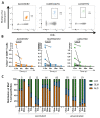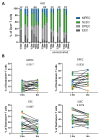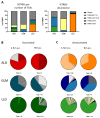Longitudinal Characterization of the Mumps-Specific HLA-A2 Restricted T-Cell Response after Mumps Virus Infection
- PMID: 34960178
- PMCID: PMC8707000
- DOI: 10.3390/vaccines9121431
Longitudinal Characterization of the Mumps-Specific HLA-A2 Restricted T-Cell Response after Mumps Virus Infection
Abstract
Waning of the mumps virus (MuV)-specific humoral response after vaccination has been suggested as a cause for recent mumps outbreaks in vaccinated young adults, although it cannot explain all cases. Moreover, CD8+ T cells may play an important role in the response against MuV; however, little is known about the characteristics and dynamics of the MuV-specific CD8+ T-cell response after MuV infection. Here, we had the opportunity to follow the CD8+ T-cell response to three recently identified HLA-A2*02:01-restricted MuV-specific epitopes from 1.5 to 36 months post-MuV infection in five previously vaccinated and three unvaccinated individuals. The infection-induced CD8+ T-cell response was dominated by T cells specific for the ALDQTDIRV and LLDSSTTRV epitopes, while the response to the GLMEGQIVSV epitope was subdominant. MuV-specific CD8+ T-cell frequencies in the blood declined between 1.5 and 9 months after infection. This decline was not explained by changes in the expression of inhibitory receptors or homing markers. Despite the ongoing changes in the frequencies and phenotype of MuV-specific CD8+ T cells, TCRβ analyses revealed a stable MuV-specific T-cell repertoire over time. These insights in the maintenance of the cellular response against mumps may provide hallmarks for optimizing vaccination strategies towards a long-term cellular memory response.
Keywords: MMR vaccination; T-cell immunity; mumps infection.
Conflict of interest statement
The authors declare no competing interests.
Figures




Similar articles
-
Identification of Naturally Processed Mumps Virus Epitopes by Mass Spectrometry: Confirmation of Multiple CD8+ T-Cell Responses in Mumps Patients.J Infect Dis. 2020 Jan 14;221(3):474-482. doi: 10.1093/infdis/jiz480. J Infect Dis. 2020. PMID: 31560392
-
The Human CD4+ T Cell Response against Mumps Virus Targets a Broadly Recognized Nucleoprotein Epitope.J Virol. 2019 Mar 5;93(6):e01883-18. doi: 10.1128/JVI.01883-18. Print 2019 Mar 15. J Virol. 2019. PMID: 30626672 Free PMC article.
-
Novel mumps virus epitopes reveal robust cytotoxic T cell responses after natural infection but not after vaccination.Sci Rep. 2021 Jul 1;11(1):13664. doi: 10.1038/s41598-021-92926-1. Sci Rep. 2021. PMID: 34211021 Free PMC article.
-
Unique Tropism and Entry Mechanism of Mumps Virus.Viruses. 2021 Sep 1;13(9):1746. doi: 10.3390/v13091746. Viruses. 2021. PMID: 34578327 Free PMC article. Review.
-
Mumps in the Vaccination Age: Global Epidemiology and the Situation in Germany.Int J Environ Res Public Health. 2018 Jul 31;15(8):1618. doi: 10.3390/ijerph15081618. Int J Environ Res Public Health. 2018. PMID: 30065192 Free PMC article. Review.
Cited by
-
First-in-human immunoPET imaging of COVID-19 convalescent patients using dynamic total-body PET and a CD8-targeted minibody.Sci Adv. 2023 Oct 13;9(41):eadh7968. doi: 10.1126/sciadv.adh7968. Epub 2023 Oct 12. Sci Adv. 2023. PMID: 37824612 Free PMC article.
References
-
- MacDonald N., Hatchette T., Elkout L., Sarwal S. Mumps is Back: Why is Mumps Eradication Not Working? Adv. Exp. Med. Biol. 2011;7:197–220. - PubMed
-
- Plotkin S.A., Orenstein W.A., Offit P.A. Vaccines. Elsevier; Philadelphia, PA, USA: 2018.
LinkOut - more resources
Full Text Sources
Molecular Biology Databases
Research Materials

